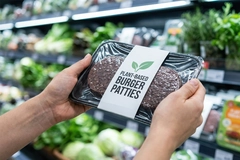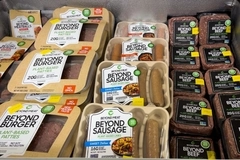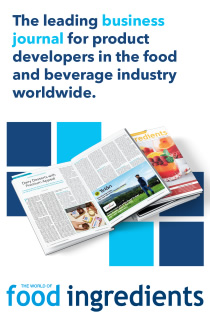
- Industry news
Industry news
- Category news
Category news
- Reports
- Key trends
- Multimedia
- Journal
- Events
- Suppliers
- Home
- Industry news
Industry news
- Category news
Category news
- Reports
- Key trends
- Multimedia
- Events
- Suppliers
Scientists tap AI to elevate plant-based meat texture for enhanced consumer appeal
 First author Skyler St. Pierre and senior author Ellen Kuhl with the team (Image credit: Kurt Hickman/Stanford University).
First author Skyler St. Pierre and senior author Ellen Kuhl with the team (Image credit: Kurt Hickman/Stanford University).Researchers at Stanford University in the US are working to close the texture gap between plant-based meat and animal meat by combining a three-dimensional mechanical technique and AI to mimic human sensory experience. The team aims to enhance consumer acceptance of plant-based meat and encourage open-access data to accelerate innovation in the segment.
Viewing the plant-based meat texture challenge from a mechanical engineering angle, the researchers say they are “pioneering a new approach to food texture testing that could pave the way for faux filets that fool even committed carnivores.”
“AI is a powerful tool that lets us find patterns in data that we might not otherwise be able to spot. In our study, we used AI to help us automatically discover the best material model and material parameters for each meat,” Skyler St. Pierre, a PhD student in mechanical engineering and first author of the study, tells Food Ingredients First.
“We used three experimental tests to mimic the chewing process: tension, compression and shear. For tension, we pulled rectangular samples of meat until they broke.”
Testing meat stiffness
The team mechanically tested eight products for the study, including an animal and plant-based hot dog, sausage, turkey and extra firm and firm tofu.
They mounted bits of meat into a machine that mimics human chewing actions.
 Ethan C. Darwin, the study’s co-author, testing the samples (Image credit: Kurt Hickman/Stanford University).“For compression, we pushed circular samples down, and for shear, we rotated the top surface of the circular sample while the bottom surface stayed fixed. We made sure that each sample was stretched, compressed or sheared at least 10%,” he explains.
Ethan C. Darwin, the study’s co-author, testing the samples (Image credit: Kurt Hickman/Stanford University).“For compression, we pushed circular samples down, and for shear, we rotated the top surface of the circular sample while the bottom surface stayed fixed. We made sure that each sample was stretched, compressed or sheared at least 10%,” he explains.
The findings, published in Science of Food, reveal that plant-based sausage and hotdog successfully mimic their animal counterparts, while tofurkey, an American vegan turkey substitute made from a blend of wheat protein and organic tofu, was found to be twice as stiff and tofu twice as soft.
“Our team of undergraduates was most surprised to see how stretchy the animal hotdog was. We didn’t expect the products to stretch to more than 30% before failing,” says St. Pierre.
Ellen Kuhl, professor of mechanical engineering and senior author of the study, adds: “We ranked all eight products by their stiffness, first from mechanical testing and then from our own perception when eating them. What’s really cool is that both rankings were nearly identical. This means we can really taste how stiff a product is.”
The team then used machine learning to process the data from these tests.
However, Kuhl acknowledges that the team needs more data to utilize AI fully. “We’d like to invite everyone who has a viable product to share it with us to test and make the data available open source for everyone to use.”
 The team tested samples of animal and plant-based hot dog, sausage, turkey and extra firm and firm tofu (Image credit:Kurt Hickman/Stanford University).The team’s work was also restricted because some plant-based meats were “either too soft or too crumbly to be able to stretch in tension,” says St. Pierre.
The team tested samples of animal and plant-based hot dog, sausage, turkey and extra firm and firm tofu (Image credit:Kurt Hickman/Stanford University).The team’s work was also restricted because some plant-based meats were “either too soft or too crumbly to be able to stretch in tension,” says St. Pierre.
Standardizing alt-meat testing
Food scientists analyze the texture of plant-based meat products to replicate animal meat. However, traditional food testing methods are not standardized and the results are rarely made available to science and the public, making collaboration and cross-study comparisons difficult, flags St. Pierre.
“A second limitation is that the currently used tests do not always include well-defined material properties from materials science. Here, we have defined a standard set of protocols that allow us to determine the material properties of meat in a rigorous manner.”
For Kuhl, standardizing and automating the process to characterize alternative protein products will make testing and comparing these new products “more accessible” and “democratize alternative protein design.”
“This will allow smaller businesses to develop competitive solutions and ultimately accelerate the transition to a healthier food system.”
The AI-based method for food testing can also be applied to soft materials like plant-based seafood.
Driving innovation
In the future, St. Pierre says the team hopes to inspire others to make their data open-access to accelerate the innovation of plant-based meats.
“Our study also provides a clear protocol that others could follow to be able to compare their meats to the ones we tested directly. Lastly, we show that combining both testing and tasting allows for novel insights into how people perceive the material properties of meat,” he says.
 The team now plans to create a large open-access database for various animal and plant-based meat and train AI to improve them.The team is currently exploring a collaboration to apply the method to fungi-based products as well, Kuhl tells us. “This is exciting because filamentous fungi can generate a similar texture to animal meat, which many plant-based products can not.”
The team now plans to create a large open-access database for various animal and plant-based meat and train AI to improve them.The team is currently exploring a collaboration to apply the method to fungi-based products as well, Kuhl tells us. “This is exciting because filamentous fungi can generate a similar texture to animal meat, which many plant-based products can not.”
They also plan to explore if AI can design the optimal formula for a new alternative protein product with desired properties that is both healthy and environmentally friendly.
Meanwhile, the team will “continue testing and tasting meat,” says St. Pierre.
“We have a vision of creating a large open-access database with many types of animal and plant-based meat that we could then train an AI to determine the optimal ingredients for processing methods to make better plant-based meats.”

















